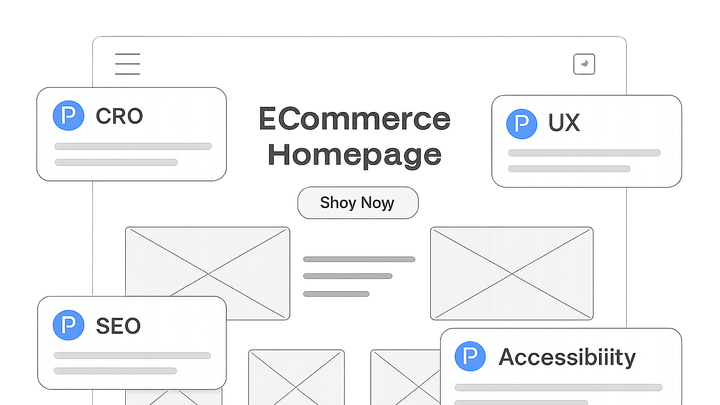Published on 2025-06-29T22:03:21Z
What is an eCommerce Homepage Review? Examples & Best Practices
An eCommerce homepage review is the systematic assessment of an online store’s main landing page to identify strengths and improvement areas in CRO, UX, SEO, and accessibility.
This evaluation covers design elements, content hierarchy, navigation, performance, metadata, and compliance with WCAG accessibility standards.
The goal is to optimize the user journey, increase engagement, and maximize conversions by addressing friction points and enhancing clarity.
Common methods include heuristic analysis, user testing, analytics audits, and A/B testing. Tools like Prevue.me provide actionable critiques for lead generation, SEO, UX, and accessibility.
Regular homepage reviews help boost conversion rates, reduce bounce, improve search visibility, and ensure an inclusive shopping experience.
Ecommerce homepage reviews
Systematic evaluation of an eCommerce homepage focusing on CRO, UX, SEO, and accessibility to boost conversions and user satisfaction.
Key Components of eCommerce Homepage Reviews
A breakdown of the primary aspects evaluated during an eCommerce homepage review.
-
Design and visual hierarchy
Evaluate the layout, visual balance, and emphasis on key elements like banners and CTAs.
- Visual hierarchy:
Check that headlines, images, and CTAs guide the eye in the intended order.
- Brand consistency:
Ensure colors, fonts, and imagery align with the brand identity.
- Visual hierarchy:
-
Content and messaging
Assess copy clarity, value proposition prominence, and tone of messaging.
- Value propositions:
Verify that unique selling points are clear and compelling.
- Call-to-action clarity:
Ensure CTAs use actionable language and stand out visually.
- Value propositions:
-
Navigation and usability
Test menu structures, search functionality, and intuitive pathways.
- Menu structure:
Confirm categories are logical, labeled clearly, and accessible.
- Search functionality:
Check search bar visibility, filtering options, and accuracy.
- Menu structure:
-
Performance and accessibility
Measure page load speed, mobile responsiveness, and accessibility compliance.
- Page speed:
Monitor load times and optimize assets to reduce delays.
- Wcag compliance:
Ensure text contrast, alt tags, and keyboard navigation meet guidelines.
- Page speed:
-
Seo optimization
Review metadata, internal linking, and on-page keyword usage.
- Meta titles & descriptions:
Check for unique, descriptive, and keyword-rich metadata.
- Internal linking:
Ensure logical linking structure for SEO and user flow.
- Meta titles & descriptions:
Methodologies and Best Practices
Common approaches and frameworks for conducting effective homepage reviews.
-
Heuristic evaluation
Use expert-driven checklists to identify usability issues based on established principles.
- Nielsen's heuristics:
Apply recognized usability heuristics to spot navigational and design flaws.
- Custom checklists:
Tailor review criteria to your brand and audience needs.
- Nielsen's heuristics:
-
User testing
Gather qualitative feedback from real users to observe pain points and behaviors.
- Moderated sessions:
Guide users through tasks and collect direct insights.
- Unmoderated tools:
Use remote testing platforms for scalable feedback.
- Moderated sessions:
-
Analytics audit
Analyze metrics like bounce rate, time on page, and conversion funnels for quantitative insights.
- Behavior flow:
Track user paths to identify drop-off points.
- Event tracking:
Monitor clicks on CTAs, forms, and key elements.
- Behavior flow:
-
A/b testing
Compare variations of page elements to determine which drives better performance.
- Hypothesis development:
Form clear test hypotheses based on observed data.
- Statistical significance:
Ensure tests run long enough to yield reliable results.
- Hypothesis development:
Leveraging SaaS Tools: Prevue.me
How to use prevue.me to gain actionable critiques across CRO, lead generation, SEO, UX, and accessibility.
-
Actionable cro feedback
Identify and prioritize conversion hurdles through expert analysis.
- Friction point identification:
Highlight areas where users hesitate or drop off.
- Cta optimization:
Recommend improvements to button copy, placement, and design.
- Friction point identification:
-
Lead generation optimization
Enhance forms and landing elements to capture more qualified leads.
- Form field analysis:
Ensure form length and labels maximize completion rates.
- Offer alignment:
Match incentives (e.g., discounts, content) to audience intent.
- Form field analysis:
-
Seo & technical audits
Receive comprehensive reports on metadata, site structure, and performance.
- Keyword recommendations:
Suggest on-page keywords and content topics.
- Technical fixes:
Surface issues like broken links, missing alt tags, and slow resources.
- Keyword recommendations:
-
Ux & accessibility critiques
Assess navigational ease and compliance with accessibility standards.
- Assistive tech compatibility:
Ensure screen reader friendliness and keyboard accessibility.
- Usability enhancements:
Recommend layout and interaction improvements for all users.
- Assistive tech compatibility:
Measuring Impact and ROI
Key metrics and indicators to evaluate the success of homepage improvements.
-
Conversion rate metrics
Track overall and segmented conversion rates before and after changes.
- Global conversion rate:
Measure percentage of visitors completing purchases.
- Segmented analysis:
Compare performance by traffic source or user cohort.
- Global conversion rate:
-
Engagement and behavior metrics
Analyze bounce rates, session duration, and pages per session for engagement insights.
- Bounce rate:
Monitor reductions in single-page visits.
- Time on page:
Assess whether content changes improve user engagement.
- Bounce rate:
-
Search performance metrics
Observe ranking changes, organic traffic growth, and click-through rates.
- Keyword rankings:
Track target keywords’ positions on SERPs.
- Organic click-through rate:
Measure how metadata changes affect traffic from search.
- Keyword rankings:
-
Accessibility compliance
Verify improvements in accessibility audit scores and issue resolution rates.
- Audit score improvement:
Compare WCAG compliance scores before and after fixes.
- Resolved issues:
Count accessibility errors addressed over time.
- Audit score improvement:
